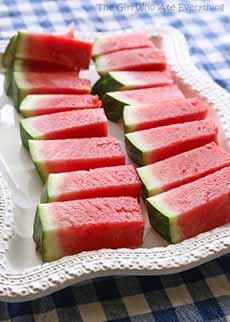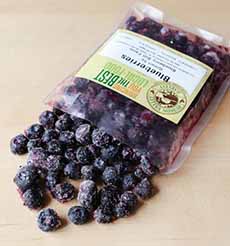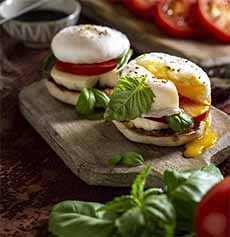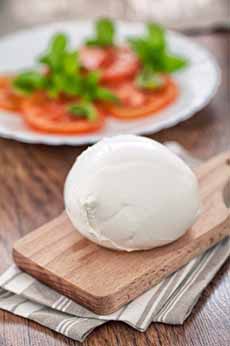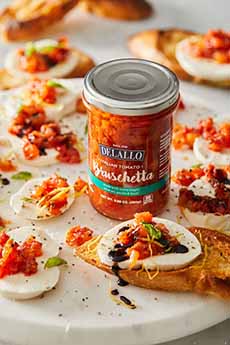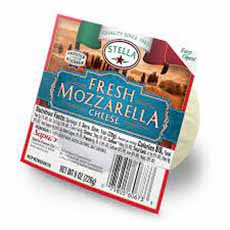|
We love these summer rolls from the California Avocado Commission. It is adapted from Thai summer roll recipes.
Made with gluten-free rice paper, rice noodles, lettuce and pickled vegetables, it is light and refreshing: great summer fare.
You can make a lunch of them, snack on them, or serve them with summer drinks: iced tea, lemonade, frozen cocktails…plus wine and beer.
The recipe makes 12 spring rolls, which can be cut in thirds or sixths (photo #1) for bites. We can easily eat two whole rolls for lunch.
If you don’t want the spicy sambal condiment, you can use peanut dipping sauce.
You can also add chicken or shrimp—or substitute either for the avocado.
RECIPE: CALIFORNIA AVOCADO SUMMER ROLLS
Ingredients
12 spring roll wrappers (a.k.a. rice paper wrappers – photo #5)
24 Bibb* lettuce leaves
9 large† California avocados, peeled, seeded, quartered and sliced lengthwise in thirds* (photo #4)
3/4 cup Thai basil leaves††
3/4 cup mint leaves
3 cups pickled vegetable mixture (recipe follows)
3 cups cooked and cooled rice vermicelli noodles
Optional: cooked chicken batons or halved cooked shrimp
1-1/2 cups sambal Thai chili paste (make or buy; recipe follows)
Ingredients For The Pickled Vegetable Mixture (3 Cups)
2-1/2 cups champagne vinegar (substitute white wine vinegar)
2 cups sugar
3/4 cup water
1 teaspoon coriander seeds
1 teaspoon chili flakes
1 bay leaf
3 cups carrots, julienned (photo #4)
1-1/2 cups scallion, sliced
1-1/2 cups cucumber, julienned
Ingredients For Sambal Paste (1½ Cups) — Photo #3
1-1/2 cups Fresno chilies, stems removed
1/4 cup champagne vinegar
2 tablespoons sugar
1 garlic clove
1 tablespoon soy sauce
6 tablespoons honey
2 tablespoons lime juice
1/2 teaspoon xanthan gum‡‡
Preparation
1. MAKE the pickled vegetables the day before (or longer): Place the carrots, green onions, and cucumber in a heatproof bowl. Combine the vinegar, sugar, water, coriander, chili flakes and bay leaf in a saucepan. Bring to a boil.
2. POUR the vinegar mixture over the vegetables and allow to cool for 2 hours at room temperature. Refrigerate for at least 12 hours to pickle.
House Sambal:
3. MAKE the sambal (we purchased a jar of it sambal). If making from scratch, combine all ingredients in a commercial blender. Process on low speed for coarse texture.
4. ASSEMBLE: Working one at a time, moisten a spring roll wrapper with water until it’s pliable and easy to work with. Place 2 Bibb lettuce leaves on the wrapper, 1 inch from the edge closest to you. Layer on 3 avocado slices, 1 tablespoon of Thai basil, 1 tablespoon of mint, ¼ cup pickled vegetable mixture, and ¼ cup cooked rice vermicelli.
5. STARTING with the edge closest to you, tightly roll the spring roll. Trim ¼” off each end, then cut into 6 equal pieces. Repeat with remaining spring roll wrappers.
6. PLATE each roll (6 pieces) standing up, and serve with 2 tablespoons of the sambal.
________________
*If you can’t find Bibb, you can substitute Boston lettuce, but the leaves are larger. You can also use red or green leaf lettuce, which are also larger leaves and will need to be torn to size.
†A large avocado averages about 8 ounces. If using smaller or larger avocados, adjust the quantity accordingly.
‡Thai basil has notes of anise and is slightly spicy. It works well with Southeast Asian recipes. If you can’t find Thai basil (best place is a farmers market), use conventional Italian basil (a.k.a. sweet basil) and add a few fresh mint sprigs to the recipe. However…since the recipe above already includes mint leaves, you don’t have to add more mint.
‡‡Xanthan gum is a common food additive used as a thickener or stabilizer. It binds ingredients together so they don’t separate. Many dressings, sauces and other products use it to prevent separation and increase the thickness of the product.
|
|
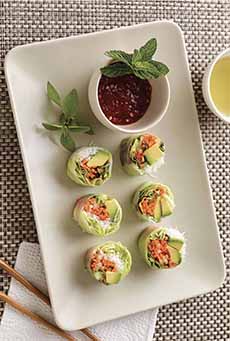
[1] Avocado summer rolls (photo and recipe © California Avocado Commission).

[2] Slice avocado wedges (photo © Love One Today).

[3] Sambal sauce (photo © McCormick).

[4] Carrots are julienned, then pickled overnight with scallions and cucumbers (photo © Juniart | Panther Media).
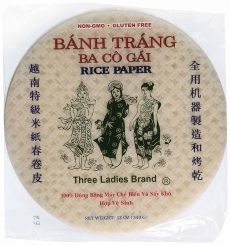
[5] Spring roll wrappers also called rice paper wrappers, can be purchased at any Asian food store or online (photo © Three Ladies | Amazon).
|
